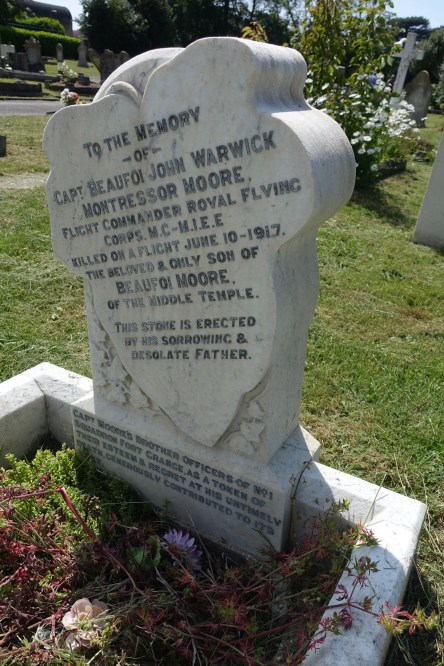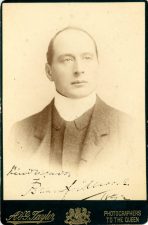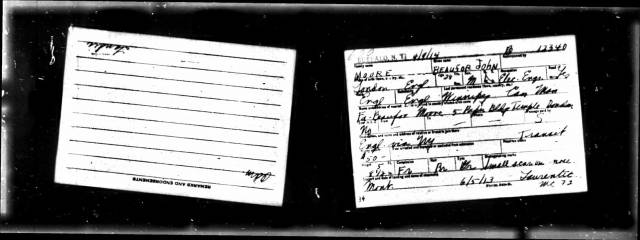Captain Beaufoi John Warwick Montressor Moore M.C. M.I.E.E. died on 10th June 1917 whilst flying from Grange Airfield at Gosport.

He was the son of Beaufoi and Cecilia Moore of 4 Pump Court, Temple, London. When war was declared against Germany in 1914, for medical reasons, he was not allowed a commission in the Army and he Joined the R.F.C. as an air mechanic class 1. He was an electrical engineer, having served his time in the works of Messrs. J. C. Fuller and Son, electrical and telegraph engineers, of Woodland Works, Chadwell Heath. He was a member of the Institute of Electrical Engineers. After a short time, his potential was noticed and he was commissioned. As an officer he qualified as a pilot, and soon went to the front in France. He remained there for about 12 months and during this time he was awarded the Military Cross for his bravery.
The London Gazette states: For conspicuous gallantry and skill. He has destroyed two enemy kite balloons, one of which was being guarded by an enemy aeroplane. He has repeatedly attacked hostile aircraft, on one occasion attacking a flight of four, all of which he drove down and two of which he followed to 2,000 ft., one being apparently hard hit. He received his award in February 1917 at Buckingham Palace.
He was selected to give instruction in the manoeuvring of the latest types of aircraft and was posted back to Grange Aerodrome, where he became one of the Instructors, rising to command No 1 Training Squadron.
He was part of the Flying School at Grange established by the famous Smith Barry. Alverbank House at Stokes Bay was rented, from the Platts who owned it, by Scott Barry and his team of Officers, to be used as an extension to the Officer’s Mess. Here they began experimenting on a method of communication between instructor pilots and pupils, later to become famous as ‘The Gosport Tube’. The problem of communicating with pupils in the air was baffling and Smith Barry was determined to solve it.

On the 10th of June 1917 Captain Moore nicknamed ‘Granny’ by virtue of the fact that he was the oldest of the instructors at Grange, took off in an Avro 504B ‘B’ service no 1399. In the rear seat, was Captain Heard who was under flying instruction. During the flight, Capt. Moore turned around to give instruction to his pupil, whilst trying to make himself heard, he had not realised that the aeroplane had begun to loose height and was now flying at about 60 feet above the ground. The machine collided with a tall tree on Lee-on-Solent Golf Links. Rescuers rushed from the airfield to the scene and the two occupants were taken from the wreckage, which had fallen to the foot of the tree. A Medical Officer who arrived on the scene just after the accident stated that on its fall, the machine was on fire and smashed, Captain Moore was lying beside it quite dead, but Captain Heard who was lying some distance away was conscious. Captain Moore sustained terrible injuries, and died instantaneously. A verdict of accidental death was returned.
F.D. Tredrey gives the following account of the accident, related by Captain Parker, in his book ‘Pioneer Pilot’:
It was a beautiful Sunday morning that I tried out one set with a pupil I was teaching and we were delighted that we could hear what each other said as though we were speaking without engine noise. I was most excited with the result and I asked my pal Capt. Moore who was just going up to put a set in his machine and he said he would as soon as he came down from a flight he had to make with a pupil, and he took off in his machine. A few minutes later a mechanic rushed over to me and said Captain Moore had come down near the golf course. I immediately got into my machine and flew out to the golf course and there I saw stuck in a large oak tree Capt. Moore’s machine. I landed close by and found the pupil sitting under a hedge a bit dazed but with no other serious injury than a cut lip, but Granny’ Moore was still motionless in the front seat of the machine in the oak tree. Some helpers came along and we lifted ‘Granny’ to the ground and alas he was dead. It was afterwards reported that the impact had ruptured his heart. It was assumed that as ‘Granny’ was an excellent pilot he must have been engaged looking back talking to the pupil with the engine slow-running to reduce noise, and did not notice that he was so near the ground. Had he only put in the set of speaking tubes I offered him his life would undoubtedly have been saved. When the pupil came out of hospital a couple of days later he could throw no light upon the reason for the accident as he said he did not even remember going up. This was the answer that was always given by the survivors of crashes . We buried dear old Granny in Gosport Cemetery.

Captain Beaufoi John Warwick Montressor Moore M.C., M.I.E.E. R.F.C. was buried on Wednesday 13th June 1917, and is laid to rest in Anns Hilll Cemetery at Gosport.

I am very grateful to William Jones who kindly supplied the above portrait and more details as follows:
When war began B.J.W.M. Moore was in Winnipeg, Manitoba, Canada, and enroute back to the UK in April 1914 he passed through immigration border inspection in Buffalo, NY, where he was required to submit a transit card (a copy of which is shown below). He listed his occupation as an electrical engineer and his voyage home was aboard the S.S. Laurentic of the White Star Line. I see there has been some confusion as to his first name, sometimes being recorded in online sources as Beaufor instead of Beaufoi, but gather by his headstone the latter is correct.

More on The Gosport Tube here:
Original page created by David Moore.
